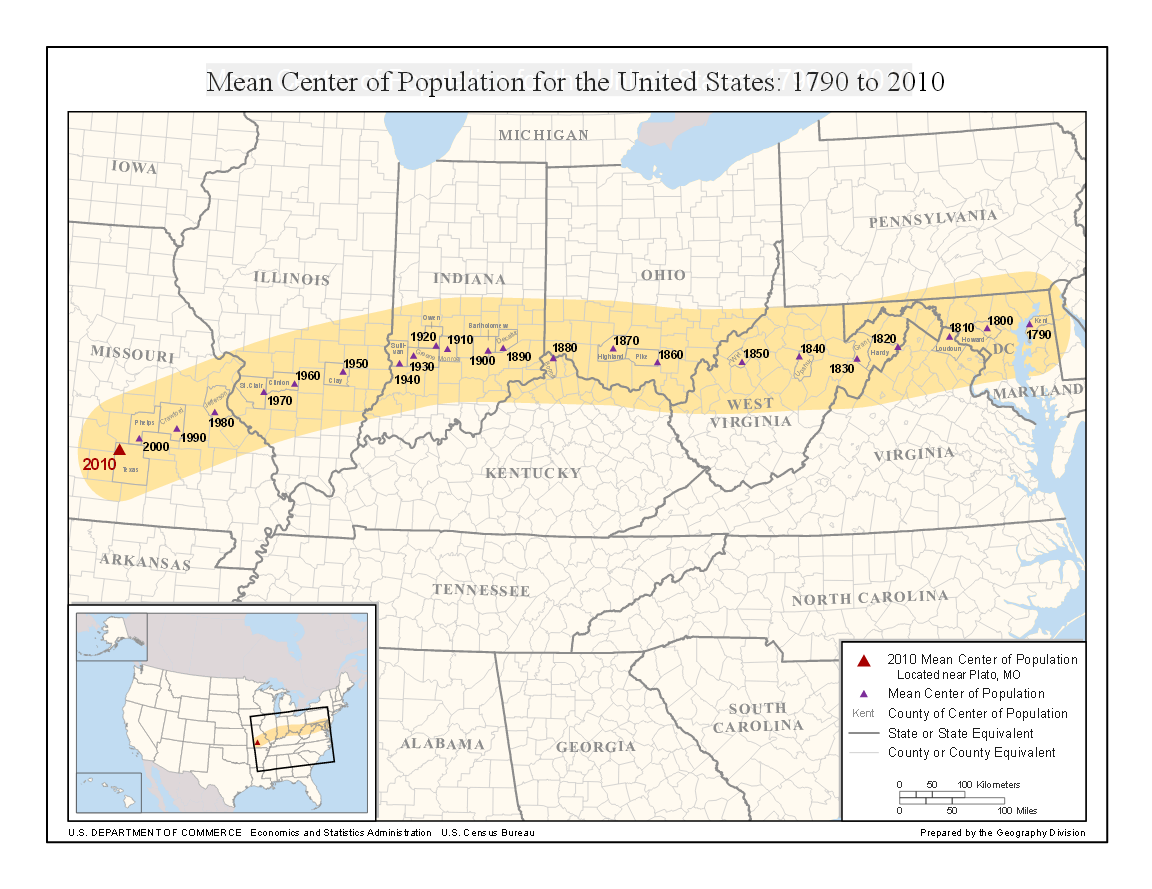Kaity Taylor
The population centre of the United States can essentially be defined as the average location where people in the United States currently live. The U.S. Census describes the population centre as, ‘If the United States map was a scale and every person had equal weight, the centre of population is the place where the scale would balance’. The concept of the population centre was devised in order to track the demographic movement of people throughout the States. Since the early days of the United States, the population and, by extension, the population centre have been shifting West. This is due to factors such as economic development, exploration and expansion. The population centre allows tracking of population distribution trends.
As previously mentioned, the population centre has been shifting over the years. The first population centre was Baltimore, Maryland, in 1870. Since then, it has moved West and to the South, with the current population centre being located in Hartville, Missouri, making this the fifth time in history that the population centre has landed in Missouri. In 2000 it was in Edgar Springs, Missouri. During the second half of the 20th century, the population centre has moved about 50 miles west every ten years.

Mean Population Centre of the U.S. from 1970-2010
Mathematical processes such as looking at average rates of change can help us analyse this movement and understand how it is studied. For example, we can use maths to express the approximate position of the population centre as a function of time since 2000. Let’s assume represents the number of years since 2000. Considering that the population centre moved 50 miles west every ten years, we can conclude that it moves at a rate of 5 miles per year. Thus, the approximate position of the population centre, measured westward from Edgar Springs along the line through Baltimore, can be given by the equation:

Straight-line distance from Baltimore, MD to Edgar Springs, MO
We can also use similar processes to determine whether the population centre could have been moving at roughly the same rate for the last two centuries. If the population centre had been moving at a rate of 5 miles per year consistently for the past two centuries, the total distance covered would be
.
This implies that the movement rate has remained relatively consistent, as it matches the distance between Baltimore and Edgar Springs.
Mathematical formulas and calculations such as these are important for a variety of reasons. Having dating such as the population centre of the United States is important because it provides us with important information about the current state and trends within the United States. This data helps policymakers, urban planners, and researchers in making informed decisions regarding infrastructure development, resource allocation, and social programs. Understanding population distribution patterns is necessary in order to for addressing the needs and challenges of an ever-changing country.
Sources
“Geographic Centers of Population: United States.” Census.gov, U.S. Census Bureau, 2021, www.census.gov/geographies/reference-files/time-series/geo/centers-population/united-states.html.
“2020 Census Reveals the United States Is a Much Different Nation.” Census.gov, U.S. Census Bureau, 2021, www.census.gov/newsroom/press-kits/2021/2020-center-of-population.html.
“Center of Population.” NOAA’s National Ocean Service, U.S. Department of Commerce, 22 Mar. 2022, oceanservice.noaa.gov/news/mar22/center-population.html.
Hughes-Hallett, D., Gleason, A. M., Lock, P. F., Flath, D. E., et al. Applied Calculus. 5th ed., Wiley, 2013.
